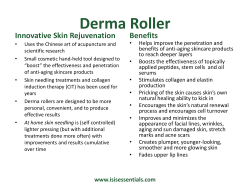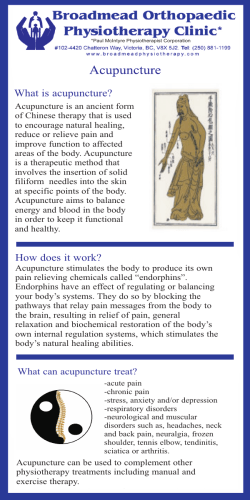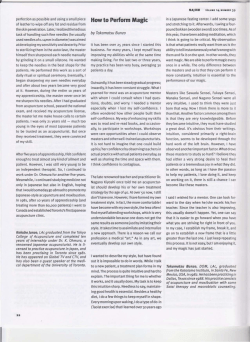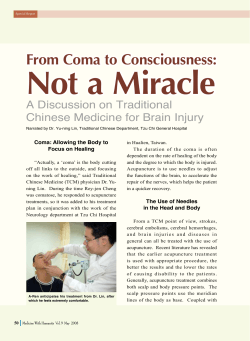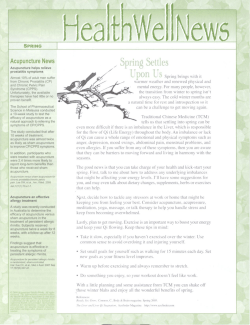
Document 236242
Objectives Intra-Muscular Manual Therapy: Dry Needling An Overview of this Unique Modality 1. Discern the differences between acupuncture & dry needling as alternative medical treatments. 2. Who can use it & Where can it be used? How do you Bill for it? 1. Correctly identify the necessary guidelines and training to performing dry needling as a physical therapist. 3. Understand the different theories and mechanisms behind the use of dry needling. 1. Understand the current evidence in order to apply dry needling in clinical practice. What is it? ∗ Dry Needling (Intramuscular Manual Therapy) is a technique using the insertion of a solid filament needle, without medication, into or through the skin to treat various impairments including, but not limited to: scarring, myofascial pain, motor recruitment and muscle firing problems. ∗ Goals for treatment vary from pain relief, increased extensibility of tissue, to the improvement of neuromuscular firing patterns. ∗ (FSBPT 2013) ∗ “intramuscular manual therapy, trigger point dry needling, or intramuscular needling” ∗ 2011: advocated using dry needling as the term of choice. (FSBPT) Why are they often confused? ∗ Dry needling is presently performed by physical therapists and chiropractors using the same solid, filiform needles as acupuncturists. ∗ They look very similar to the consumer and are often mis-labeled when reported to peers. ∗ PT’s: ∗ Do not and cannot claim to practice acupuncture ∗ Do not use acupuncture traditional Chinese medicine theories, meridian acupoints and terminology ∗ Do not use acupuncture diagnosis like tongue and pulse ∗ do not use dry needling to address things such as fertility, smoking cessation, allergies, depression or other non-neuro-musculoskeletal conditions ∗ Overall, an important distinction is that acupuncture is an entire discipline and profession where as dry needling is merely one technique which should be available to any professional with the appropriate background and training. ∗ (FSBPT,2013) What it is NOT: Acupuncture ∗ "Acupuncture" means a form of primary health care, based on traditional Chinese medical concepts and modern oriental medical techniques ∗ Employs acupuncture diagnosis and treatment, as well as adjunctive therapies and diagnostic techniques, for the promotion, maintenance, and restoration of health and the prevention of disease. ∗ Treat blockages existing within the body that can be restored by properly placing needles along energy channels called meridians. ∗ Most schools take about 3-4 years ∗ Master's degree in acupuncture or Oriental medicine Who Can Perform it? ∗ FSBPT 2012: States that allow dry needling are only allowing it to be performed by licensed physical therapists and not the support personnel. ∗ Is specifically controlled by the state practice act related to one’s profession ∗ There are currently no consistent profession-wide standards/competencies defined for the performance of dry needling. ∗ Each state has defined what the requirements will be in that state. ∗ As Texas has no official position: no requirements are available at this time ∗ KinetaCore requires a minimum of one year of experience treating patients while licensed. ∗ Accepted: Physical Therapists, Medical Doctors, Doctors of Osteopathy, Physician Assistants, Doctors of Chiropractic or Nurse Practitioners. ∗ Not Accepted: Athletic Trainers, Acupuncturists, Massage Therapists, Occupational Therapists. APTA Position Statement: Jan 2012 - 14 AMERICAN ACADEMY OF ORTHOPAEDIC MANUAL PHYSICAL THERAPISTS (AAOMPT) ∗ “Dry Needling is an invasive technique used by physical therapists (where allowed by state law) to treat myofascial pain that uses a dry needle, without medication or injection, which is inserted into areas of the muscle known as trigger points.” Dry Needling: (10/17/09) ∗ “Preliminary research supports that dry needling improves pain control, reduces muscle tension, normalizes biochemical and electrical dysfunction of motor endplates, and facilitates an accelerated return to active rehabilitation.” POSITION: It is the Position of the AAOMPT Executive Committee that dry needling is within the scope of physical therapist practice. ∗ As of March 2014, the APTA Board of Directors has now formally listed dry needling within the scope of practice. ∗ “Physical therapy, which is limited to the care and services provided by or under the direction and supervision of a physical therapist, includes: Alleviating impairment and functional limitation by designing, implementing, and modifying therapeutic interventions that include, but are not limited to: ∗ dry needling” SUPPORT STATEMENT: ∗ “Dry needling is a neurophysiological evidence-based treatment technique that requires effective manual assessment of the neuromuscular system. Physical therapists are well trained to utilize dry needling in conjunction with manual physical therapy interventions. Research supports that dry needling improves pain control, reduces muscle tension, normalizes biochemical and electrical dysfunction of motor endplates, and facilitates an accelerated return to active rehabilitation.” USA- Dry Needling - Billing ∗ The quick answer for this is YES, we can bill for Dry Needling. ∗ However, payment is dependent on your specific insurance contracts and on the state in which you practice. ∗ Billing insurance ∗ Fee for Service ∗ Must include in the POC ∗h August 12, 2011- overturned previous policy that it was not within scope Texas does not have an official position and is legally not allowed to offer advisory opinions; however, the board has made no determination that dry needling is outside the scope of practice for PTs ∗ Notify Physician if they are unfamiliar ∗ The APTA recently published remarks about the inappropriate use of the CPT’s NMR/Manual for Dry Needling APTA Public Policy, Practice, and Professional Affairs Unit 2014 ∗ “Practitioners who seek to bill any third party payer should first check the payer’s coverage policy to determine if dry needling is a covered service and if the policy specifies which code is used to report the service. ∗ Absent a specific payer policy, the use of CPT code 97140 for the performance of dry needling should not be utilized. ∗ Currently, there is no CPT code that describes dry needling nor do any of the existing CPT codes include dry needling techniques in clinical vignettes utilized by AMA in their process to establish relative value units. ∗ CPT specifically states to select the procedure or service that accurately identifies the service performed. ∗ Do not select a CPT code that merely approximates the service provided. ∗ If no such specific code exists, then report the service using the appropriate unlisted physical medicine/rehabilitation service or procedure code 97799” Definition and Technique Second: How Do They Form? What are Trigger Points Inflammatory mediators Neuropeptides Reduced pH ∗ The cause is usually multi-factorial: ∗ Overworking or overstressing muscles with activity ∗ Poor Posture leading to chronic elongation ∗ Muscular maladaptation or misuse related to firing patterns ∗ Direct Trauma or reflexive protection after an injury ∗ Blood supply is restricted due to the holding state which leads to accumulation of metabolic waste (notably hydrogen ions) which further the acidic environment and increase nociceptive sensory input. Catecholamines ∗ EMG studies have shown the MTrP is “kind of like buzzing with uncontrolled electrical activity” which causes the muscle to feel tight and can restrict motion. Cytokines 13 Third: Is It Right for You? ∗ FDN (Functional Dry Needling) can be used for a variety of musculoskeletal pathologies: ∗ ∗ ∗ ∗ ∗ ∗ ∗ ∗ Neck/Back/Shoulder MTrP pain Headaches Tennis/Golfer’s Elbow Hip/Buttock/Leg or “Sciatica” MTrp Pain Jaw or TMJ pain Whiplash Carpal Tunnel Etc. What’s the Process? Insertion of needle ∗ Active TrP = Painful ∗ Normal muscle = painless Technique: as described by Dommerholt 1. 2. 3. 4. 5. Palpate an active trigger point Cleaning the area via Place a solid filament sterile needle into the trigger point Withdraw the needle from the muscle but not from the skin. Change direction of the needle and bring it back into the same area to get more and more twitch responses 1. The muscle will ‘grasp’ the needle in what can be described as a cramping sensation 6. Elicit twitch responses until they are no longer present. Gunn IMS Pain Clinic, Research, Education http://www.istop.org Proposed Response Does It Hurt? ∗ Local: ∗ CGRP (calcitonin gene-related peptide) release ∗ This promotes vasodilation and formation of new blood vessels ∗ Segmental: ∗ Stimulation of small myelinated nerves = Enkephalin ∗ Pain blocking and modulating peptide ∗ Systemic: ∗ Beta-Endorphin released ∗ Analgesic effect ∗ FDN responses can be extremely varied and individual ∗ Typically will not feel the needle enter the skin ∗ Various Responses Include: ∗ ∗ ∗ ∗ ∗ ∗ “Pressure” over the area “Cramping” sensation “Good Pain” Surprising type discomfort Sweating or dizziness or Nausea Bruising and Soreness How Long Does it Take to Work & What Should I do Afterward? ∗ Typically, a positive response takes ~ 0-2 days ∗ This can be longer in chronic conditions ∗ It make take multiple sessions to achieve a cumulative effect Take Home Message ∗ “Remember that trigger points are rarely an isolated phenomenon, and the key to successful long-term outcomes of any treatment regime is addressing the precipitating and predisposing factors for each particular person.” ∗ After the first session: ∗ Expect to feel sore (Like a hard workout or long run) in that area ∗ Icing and topical ointments can help with the soreness ∗ Stretching is OK, avoid strenuous activity ∗ After subsequent sessions: ∗ Expect less soreness and faster improvement of symptoms. ∗ Can and Should begin to complete activity or exercises same day Huguenin 2004 Dry Needling – The Evidence Cummings et al., 2001 - Needling Therapies in the Management of Myofasial Trigger Point Pain: A Systematic Review The Evidence ∗Reviewed 23 studies ∗ Included if some form of needling therapy was used to treat muscular trigger points ∗ Concluded that direct needling of myofascial TP is an effective treatment ∗Karakurum et al., 2001 - The dry needle technique: intramuscular stimulation in tension type headache ∗ Dry needling (vs. placebo needling) resulted in significant improvement in pain and neck range of motion in patients with tension headaches Dry Needling Systematic Review Dry Needling – The Evidence Tekin et al., 2012 – The effect of dry needling in the treatment of myofascial pain syndrome: a randomized double-blinded placebo-controlled trial. Kietrys, et al ∗Compared DN vs. sham DN (placebo) ∗ Double-blinded, randomized-controlled – outpatient clinic ∗Concluded that dry needling treatment is effective in treating MPS and improving the quality of life JOSPT, 2014 12 studies ∗ Cochrane Review (Furlan, 2005) ∗ LBP (Acupuncture and DN) ∗ 35 RCTs ∗ Conclusions ∗ Acupuncture and DN may be useful adjuncts for chronic lowback pain. 24 Upper quarter dysfunction Recommende d DN for immediate and shortterm decrease in Pain References Questions Muscle Trigger Point Biochemistry ∗ Shah, 2008 ∗ 9 Subjects ∗ UT Active, latent, normal ∗ Method ∗ Microdialysis needle analysis ∗ Results ∗ Analyt concentrations were high in active MTPs compared to latent MTPs and normals 27 Energy Crisis Theory 1. APTA. Physical therapists & the performance of dry needling. www.apta.org/StateIssues/DryNeedling/ResourcePaper/. 2012. 2. Cotchett MP, Landorf KB, Munteanu SE. Effectiveness of dry needling and injections of myofascial trigger points associated with plantar heel pain: A systematic review. J Foot Ankle Res . 2010;3:18. 3. Cummings, T.M., White, A.R. Needling therapies in the management of myofascial trigger point pain: a systematic review. Arch Phys Med Rehabil: 2001. 82; 986-992. 4. Dommerholt J. Dry needling in orthopaedic physical therapy practice. Orthopedic Practice. 2004.16: 11- 16. 5. Dommerholt J, Mayoral O, and Gröbli C, Trigger point dry needling. J Manual Manipulative Ther. 2006. 14;4: E70-E87. 6. Ferrie, B.W. Treating the trigger. Advance for PT and Rehab Med. 2008. 19:6: 26. 7. Garvey, T.A., Marks, M.R., Wiesel, S.W. A prospective, randomized, double blind evaluation of trigger point therapy for lower back pain. Spine. 1989. 14; 962–964. 8. Gunn IMS Pain Clinic, Research, Education. http://www.istop.org. 2007 9. History of Dry Needling. http://www.dryneedlingcourses.com/history.html. 2009 10. Huguenin, L.K. Myofascial trigger points: the current evidence. Phys Ther in Sport: 2004.5; 2-12. 11. Karakurum, B., Karaalin, O., Coskun, O., Dora, B., Ucler, S., Inan, L. The dry needle technique: intramuscular stimulation in tension type headache. Cephalalgia. 2001. 21; 813–817. 12. Lucas KR, Polus BI, Rich PS. Latent myofascial trigger points: Their effect on muscle activation and movement efficiency. J Bodywork Mov Ther 2004.8:160-166. 13. Simons DG, Travell JG, Simons LS. Travell and Simons’ Myo- fascial Pain and Dysfunction: The Trigger Point Manual. Vol 1. 2nd ed. Baltimore, MD: Williams & Wilkins, 1999. 14. Simons DG, Hong C-Z, Simons LS. Endplate potentials are common to midfiber myofascial trigger points. Am J Phys Med Rehabil. 2002.8;212-222. 15. Tough EA, White AR, Cummings TM, Richards SH, Campbell JL. Acupuncture and dry needling in the management of myofascial trigger point pain: A systematic review and meta-analysis of randomized controlled trials. Eur J Pain. 2009;13(1):3-10. Motor End Plate Hypothesis
© Copyright 2026

